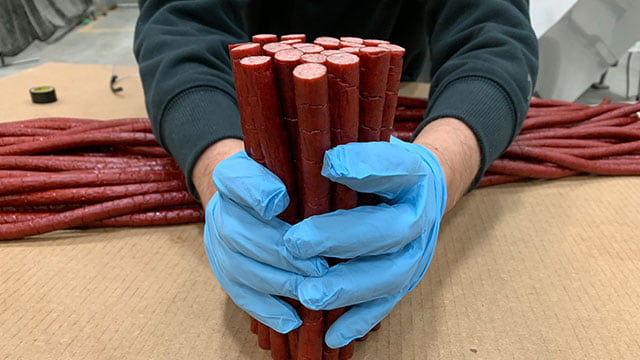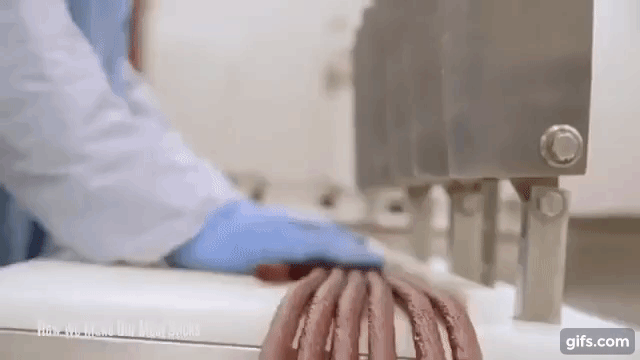The popularity of meat sticks is on the rise.
In 2017, processors made a combined total of over $1.3 billion in retail sales of meat sticks, up from $466 million in 2015. That’s almost a billion dollar increase in just two years!
Clearly, Americans love their meat sticks.
This sudden growth in popularity has left processors looking for ways to optimize their meat stick operation — to grab a larger share of the industry, outprice the competition, and make more money.
Slow Growth
The meat stick industry wasn’t always as popular as it is today.
In 2013, total sales of meat sticks only reached $383 million, and from then until 2015, only grew by $83 million in sales. That’s hardly something to write home about.

This slow growth did three things:
- Provided a relatively easy entry into the market, allowing small meat shops and individuals to develop their own meat sticks at a relatively low cost
- Made larger processors leery about investing in the market
- Stunted the development of equipment and methods to make meat stick processing more efficient
Poor Cutting = Poor Profits
Individuals and meat shops did what they could to crank out their unique flavors and styles of meat sticks, with little to no equipment designed to make the process easier and more cost effective.
One of those processes being cutting.
Go through any meat processing facility with a meat stick product, and you’ll likely find one of two methods used for cutting meat sticks.
Cutting By Hand
A number of processors are still cutting meat sticks by hand — either with just a knife and cutting board or using a snack stick mitre box.
With little to no equipment options for easily cutting meat sticks, and those that do exist costing $50,000 or more, cutting by hand is the only option for most smaller processors.
While this method will work when a meat stick brand is still small, scaling up is nearly impossible.
Cutting by hand requires a serious amount of labor — the more you produce, the more people you will need to keep up with cutting.
Cutting with Hand-Operated Equipment
The next step many processors take is to invest in hand-operated equipment, like what you see in the gif below.
While this kind of equipment will make it faster to cut meat sticks, it is still very labor intensive, requiring operators to:
- Load meat sticks onto the table
- Align meat sticks for optimal cutting
- Unload meat sticks from between blades
If that wasn’t enough, there are some other disadvantages to this type of equipment:
- Can only cut through as many sticks as the operator can push through
- The repetitive pushing movement increases the risk of costly musculoskeletal disorders
- Open or exposed cause safety concerns and lascerations
- Load and unload times are incredibly long
- Sticks may roll around causing inconsistent lengths
Losing Money
Any part of the meat stick creation process that requires intense labor will eventually eat away at profits.
The more people you need to hire to scale up production, the more costs you will incur, including:
- Wages
- Benefits
- Vacation and sick time
- Injuries and lost time
- Training and onboarding
- Decreased pace when bringing a new person on
- Human error
According to research done by The Boyd Company, the weighted average hourly earnings of general help / cutting workers in food processing range from $15.74 to $19.05. Assuming an 8 hour shift, that’s $125.92 to $152.40 per day.
As you scale up meat stick production, the number of people you need to cut meat sticks increases.
Eventually, cutting by hand or with hand-operated equipment will become too costly.
Cutting Costs, Literally
Labor is one of the largest expenses when it comes to meat stick production, and reducing the amount of labor needed to cut meat sticks will save you immensely.
Take a batch-style snack stick cutter for example (one you have to load product into and take product out of):
One of these machines ranges anywhere from $30-$60 thousand, depending on the style and manufacturer, and is capable of cutting roughly 100 sticks per minute.
Over an 8 hour shift, that’s roughly 48,000 sticks per day.

Let’s just say an employee can cut 25 sticks per minute — a high estimate given the time needed to align meat sticks, fill a cutting box, cut the sticks, and unload the sticks.
That’s 12,000 meat sticks cut per 8 hour shift, not accounting for slow down due to tiredness or mistakes.
If we assume there are 261 working days in 2019, taking weekends and holidays off, the daily cost of a batch-style snack stick cutter ranges from $115 to $230 per day.
For example, a unit costing $30,000 is cheaper per day than paying for 1 person at $15.74 per hour — and can cut four times as many meat sticks in that day than an employee can cut by hand.
Even if you need 2-3 operators for the machine, you’re still cutting more meat sticks than three operators could cut by hand.
A snack stick cutter not only cuts meat sticks, but operating costs as well — good news for meat processors in areas where minimum wage is on the rise.
Invest in Growth
When scaling up your meat stick production, investing in a stick cutter is a wise — and money saving! — choice.
We encourage you to do the math:
- How many meat sticks are your employees cutting by hand or with hand-operated cutting equipment per day?
- How much are you paying in labor for meat stick cutting?
- Is minimum wage going up any time soon, increasing your labor expenses?
Compare those answers to the benefits of a meat stick cutter:
- 48,000 sticks in an 8 hour shift
- $30-$60k price tag
- 2-3 operators per machine
Chances are, you will save quite a bit of money upgrading your meat stick cutting operation with a batch-style meat stick cutter.





